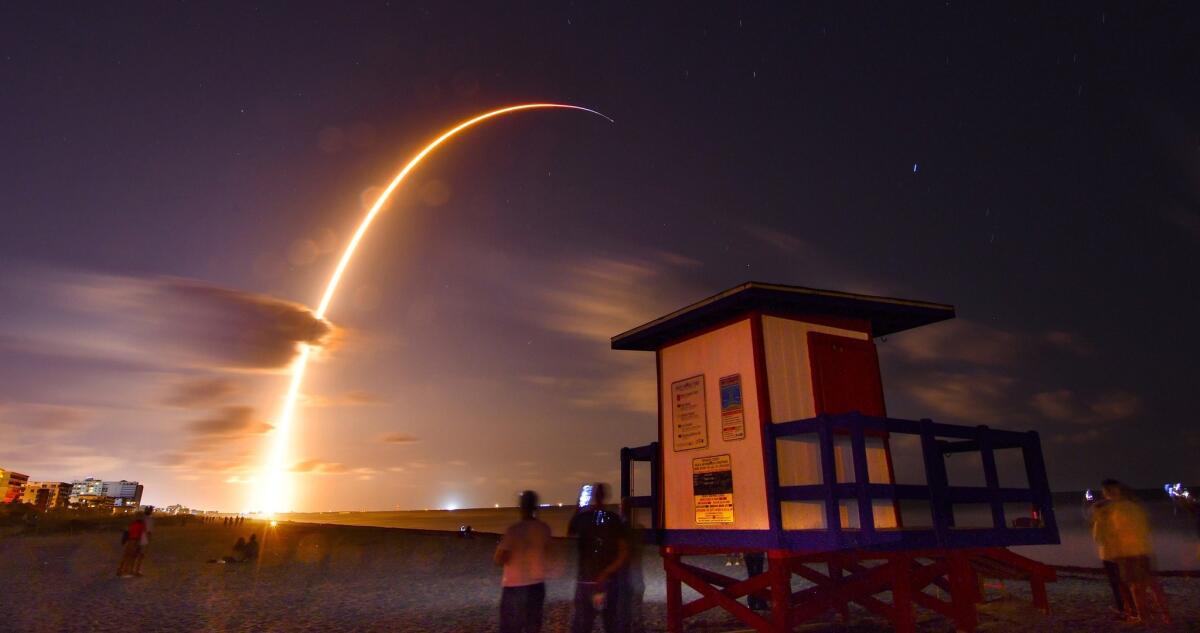SpaceX seeks permission to launch 30,000 more satellites

- Share via
SpaceX has bet its future on a network of small satellites that could beam the internet down to Earth. This month, the company’s plans got a whole lot bigger.
Hawthorne-based SpaceX has requested permission from an international regulatory group to operate as many as 30,000 satellites at a specific frequency, power level and location in space. The company had received prior permission from the U.S. government to operate about 12,000 satellites and launched 60 initial satellites in May.
The new batch of 30,000 satellites are set to be in orbits ranging from about 200 miles to 360 miles above the Earth, according to filings submitted Oct. 7 to the International Telecommunication Union, which allocates radio spectrum and satellite orbits. The filings did not include details of when the satellites would be launched.
A SpaceX spokesperson said in a statement that the company was taking steps to “responsibly scale” the total network capacity and data density to “meet the growth in users’ anticipated needs.”
SpaceX makes its money by launching satellites for commercial and government customers and ferrying cargo for NASA to the International Space Station. But company Chief Executive Elon Musk has said SpaceX’s launch revenue probably tapers off at about $3 billion a year.
The global internet connectivity market, on the other hand, is worth about $1 trillion. Musk has estimated that with the company’s Starlink satellite constellation, SpaceX could capture at least 3%, or $30 billion, of that sector.
Musk also intends to use revenue from Starlink to fund his passion project: a Mars spaceship known as Starship that would be capable of ferrying up to 100 people to the red planet. The company has started building prototypes of that spaceship near Boca Chica Beach in Texas and in Cocoa, Fla., and Musk estimated last month that a test launch reaching 60,000 feet in altitude could occur in one to two months.
“SpaceX is relying on Starlink to provide a lot of profit for them,” said Laura Forczyk, owner of space consulting firm Astralytical. “They have a lot of ambitious projects going on that they need funding for.”
But the company faces daunting technical challenges to build the high-tech satellite components cheaply enough to be affordable for users, with a level of reliability that can place it above competitors on the ground and in the sky.
Several other broadband-beaming satellite constellations have either launched or are in the works, including London’s OneWeb, which is backed by Japan’s SoftBank Group Corp. and British billionaire Richard Branson’s Virgin Group. Jeff Bezos’ Amazon.com Inc. has also entered the race with its Project Kuiper and asked the Federal Communications Commission in July for permission to launch more than 3,200 satellites.
With this in mind, part of SpaceX’s goal in filing for 30,000 satellites may be to reserve its place and prevent competitors from taking its desired orbit and frequency first.
The large number of proposed satellites might also be to ensure seamless global coverage that can provide high data rates and increased reliability, said Kerri Cahoy, associate professor of aeronautics and astronautics at MIT. SpaceX said it was investing in the future of Starlink to increase the system’s total network capacity and density, and that demand for fast and reliable internet service has escalated around the world.
With so many satellites from various constellations set to enter space, industry insiders have become increasingly concerned about potential collisions between spacecraft.
Last month, a satellite belonging to the European Space Agency had to fire its thrusters to avoid colliding with one of SpaceX’s Starlink satellites. SpaceX has said that an on-ground operator missed a message from the U.S. Air Force showing that the chance of a collision had increased, and that it is implementing “corrective actions.” The company said it has automated collision avoidance in its satellites and will be sharing spacecraft-tracking data with all other satellite operators.
SpaceX said it planned to offer service in the northern part of the U.S. and Canada as early as next year, with global coverage of more populated areas after 24 satellite launches, or a total of 1,440 satellites in orbit. More satellites could mean the company wants to serve more users, particularly in areas that are rural or semirural and have few options for internet access.
Musk said in May that SpaceX had not yet signed up any customers because it wanted to wait until the system was working well but that the company was interested in partnering with governments or telecommunications companies. Musk said he didn’t think Starlink would displace any telecommunications firms.
“The greater global coverage they can provide, the greater their market is,” Forczyk said. “The way they can increase their profit from Starlink is to increase their coverage and really make them No. 1 compared to their competitors.”
More to Read
Inside the business of entertainment
The Wide Shot brings you news, analysis and insights on everything from streaming wars to production — and what it all means for the future.
You may occasionally receive promotional content from the Los Angeles Times.











